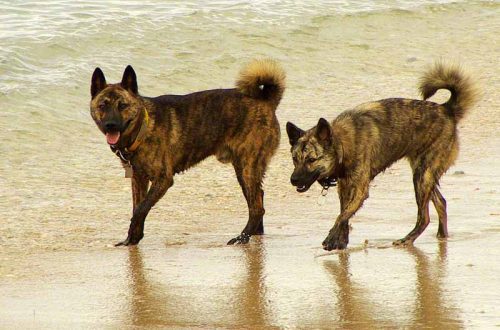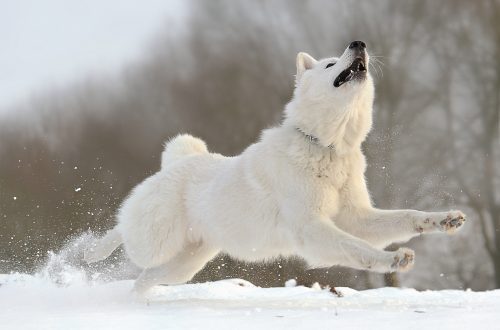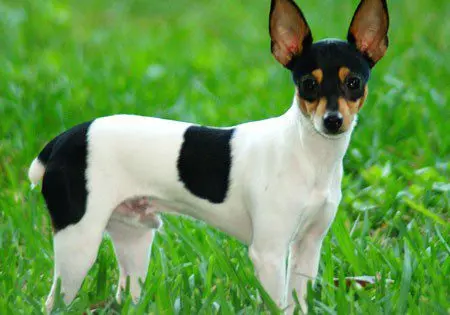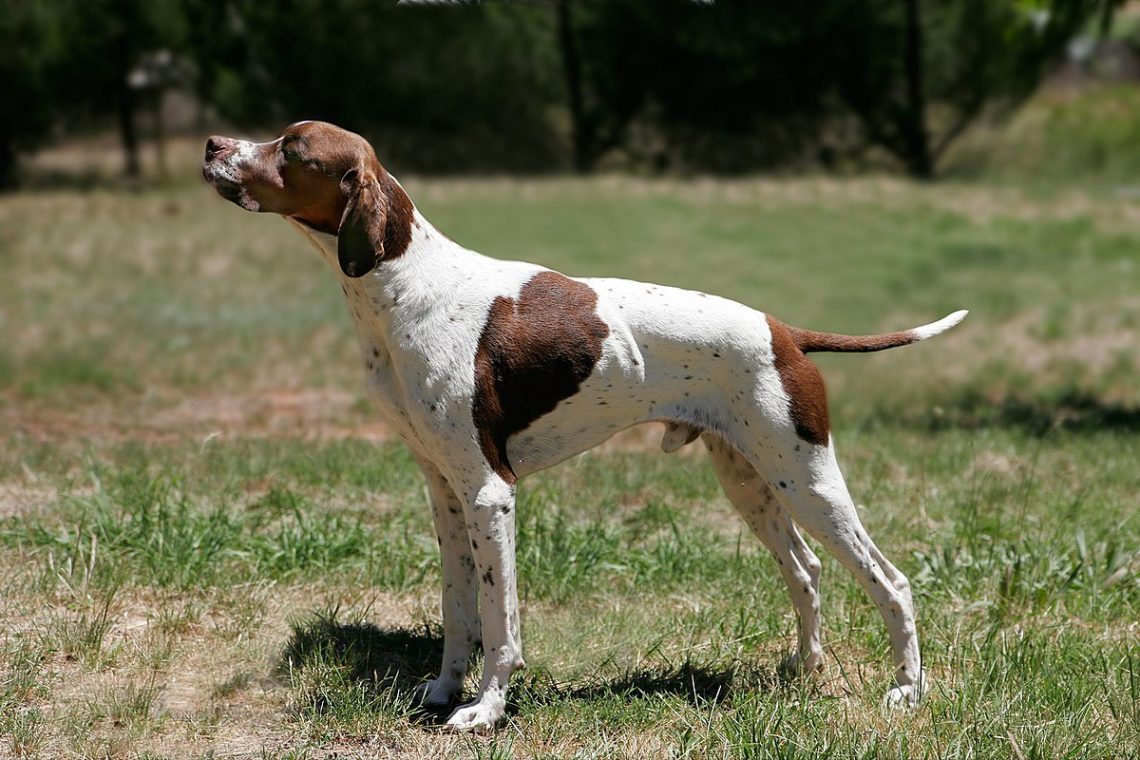
English Pointer
The English Pointer is a representative of a group of smooth-haired cops originally from Great Britain. The breed is valued for its outstanding flair and sociableness, allowing its representatives to get along with the owner’s family and pets.
Contents
- Short information
- English Pointer – Basic moments
- History of the English Pointer breed
- English Pointer breed standard
- English Pointer – Photos
- Character of the English Pointer
- Hunting with a pointer
- Education, training, coaching
- English Pointer – Maintenance and care
- Health and disease of English Pointers
- How to choose a puppy of English Pointer
- English pointer price
Short information
- Breed Name: English Pointer
- Country of Origin: UK
- Weight: 20-30 kg
- Height (height at withers): males 63-69 cm, females 61-66 cm
- Lifespan: 12-13 years
English Pointer – Basic moments
- From English, the name of the breed is translated as “arrow”, because in the stance, the pointer stretches the body, head and tail into a single horizontal line, turning into a living pointer.
- Unlike other hunting dogs, pointers like to communicate not only with the owner, but also with the rest of the household. For this reason, the breed is not recommended to be resettled for permanent residence in an aviary or booth.
- The English Pointer is often called the dog of aesthetes, for whom the process of hunting is more important than the end result.
- Pointers are more vulnerable to hunting than, for example, drathaars. The smooth short hair of the cop is not able to protect her body from sharp thorns and dry branches.
- Representatives of the breed are characterized by a long upper flair. In the field, the dog must accurately identify the smell and make a stand at a distance of at least 8-12 meters from the bird.
- Pointers can hardly endure separation from the owner and loneliness in general, so the absence of the owner should not be delayed for several days.
- Due to the short coat, the breed is quite thermophilic, so hunting trips in late autumn should be short-lived, especially if game is meant to be fed from reservoirs.
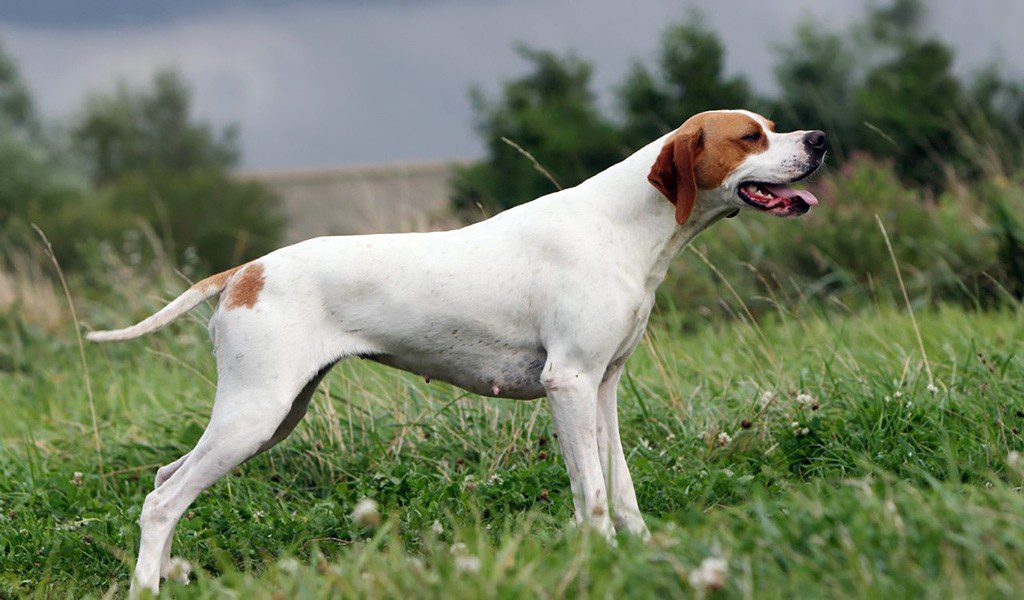
The English Pointer is an adventurous hunter and devoted companion, able to turn any outing in the field into a mesmerizing game hunting show. Combining the genes of the most prey breeds, this spectacular “birder” has a phenomenal flair and incredible hard work. It is not for nothing that pointerists enjoy well-deserved respect in hunting communities, being considered the owners of unique and elite pets. As befits an English aristocrat, the Pointer is picky enough not to mix work and home everyday life. You can not worry about your cat and other fluffy pets – out of hunting, the cop will not encroach on their lives.
Video: English Pointer
History of the English Pointer breed
The ancestors of the breed appeared in England in the 16th-17th centuries, when the old Spanish pointers and Portuguese Braccos were brought to the British Isles. The import of animals was due to practical necessity: by that time the number of game in Europe had declined and more dexterous and instinctive dogs were required to catch it than the wards of the English squires. To make the Spanish cops even more prey, the British crossed them with foxhounds, and then with bulldogs. Later, the blood of Setters, Greyhounds and Old French Braques was added to the resulting cross, which added restrained aristocracy to the appearance of Pointers.
To participate in exhibitions, as an independent breed, English pointers began in 1877. Around the same time, the cops were brought to the United States, where they demonstrated such brilliant success in work that they overshadowed the setters popular with Americans. Pointers appeared in Russia earlier than in the States – the breed has been mentioned in domestic print publications since 1842. The animals were kept mainly by representatives of the nobility, who ordered pedigree males and females straight from England.
The cops were deliberately exterminated as pets of the hated bourgeoisie, and those individuals who were lucky to survive no longer had pedigrees and traded in vagrancy. In the early 1920s, A. A. Chumakov undertook to “reanimate” the kind of English pointers. It was thanks to his efforts that the Moscow lines of the breed did not die out of starvation during the Great Patriotic War and almost completely preserved the livestock. By the way, the breeder himself was categorically against mating his own pets with imported pointers. In his opinion, foreign manufacturers could not bring anything outstanding to the phenotype of the Soviet cops.
An interesting fact: in England, Judy is considered the most famous pointer. Since 1936, the dog lived on board the British boat Gnat, with whose crew she survived the Battle of Singapore, the sinking of the ship, Japanese captivity and a month and a half passage through the jungle. For saving the lives of the crew members and dedication, Judy was awarded the Maria Deakin Medal.
English Pointer breed standard
According to external characteristics, the pointer is an ideal cop: strong, hardy, but at the same time not losing its natural grace and refinement of appearance. In the exterior of the breed, although in a muted form, there is a noticeable resemblance to the Foxhounds. As for the elegance of the silhouette and the ease of movement, they moved to the pointers from greyhounds and setters. In the hunting environment, working with an English Pointer is valued not so much for its effectiveness, but for the hypnotic charm of the process itself. The breed is looking for game in a smooth quarry, aligning its back, muzzle and tail into a common horizontal line in a stance. The animal looks very impressive in a stance with its front paw raised up – it was in this position that the artists of the 19th century liked to capture English pointers on their canvases.
Head
The skull of the dog is harmonious, moderately wide, with a prominent occiput and stop. The muzzle is obtuse-angled, slightly sunken under the eyes.
Lips, teeth and jaws
English Pointers have large, delicate lips. The reference type of bite of the breed is full scissors. The upper teeth are arranged vertically in a row, hanging over the lower ones.
Nose
The back of the muzzle has a small depression in the middle, which is why the nose of the cop looks slightly upturned. Nostrils large, wet, soft. The earlobe is colored in a dark tone, which is slightly lighter in dogs with a lemon-white coat.
Eyes
Depending on the suit, the iris of the eyes can be light brown or brown. The skin of the eyelids of most Pointers is dark, with the exception of lemon-white individuals. The expression of the eyes is intelligent, calm, without impudence and challenge.
Ears
A thin ear cloth is distinguished by a rounded tip, a high set and a snug fit to the head. The ears themselves are of medium length.
Neck
The elongated muscular neck is devoid of dewlap, but has a slight bend and smoothly merges into the body.
Frame
The body of the English Pointer is strong, flexible, but without excessive bulkiness. A wide, strong chest gradually tapers in the region of a short, convex loin. The ribs are strongly curved and laid back. The lower part of the chest descends to the elbows, the croup is in line with the lower back.
Limbs
The legs of the English Pointer are even, bony, with excellently developed muscles. The forearms are strong, with pronounced tendons on the back. The shoulder blades are oblique, set at a good slope. The front part of the wrists is of a flattened type, the inner part protrudes slightly forward and passes into long sloping pasterns. The hind legs are muscular, with large thighs, long lower legs and short metatarsus. The paws of the pointer are oval in shape, tightly built, with arched toes and dense pads. The dog moves easily, sweepingly, with a strong push of the hind legs.
Tail/rod
The tail is of medium length, very thick at the base and narrowed at the tip. The rod does not bend upwards and is held no higher than the level of the back. Waving it from side to side in motion is unacceptable.
Wool
The short, stiff coat of the English Pointer has a silky natural sheen. The hair is straight, evenly distributed throughout the body.
Color
The most common colors of the breed are lemon-white, black-and-white, liver-white and orange-white. More rare colors are solid and tricolor.
Disqualifying vices
The severity of exterior and behavioral defects directly affects the show career of the animal. Individuals with minor defects in appearance are allowed in the ring, but pointers that have lost their breed habits and appearance are not. Cowardly or aggressive dogs do not take part in exhibitions, inadequately responding to the demands of the handler, refusing to perform in front of the public, and also trying to use force against other four-legged contestants and people.
English Pointer – Photos
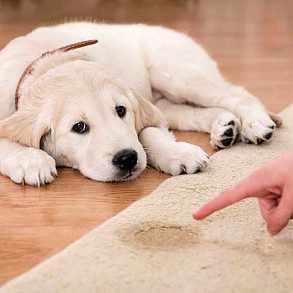

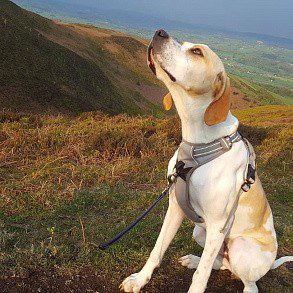

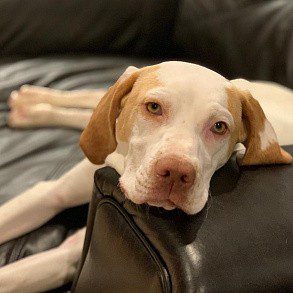

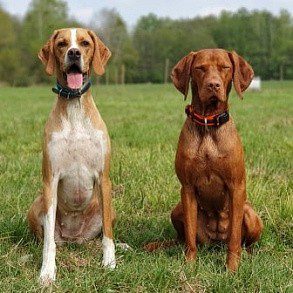



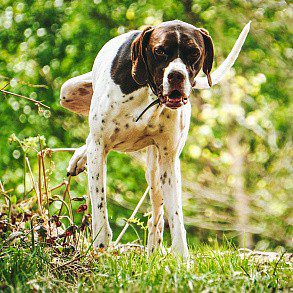



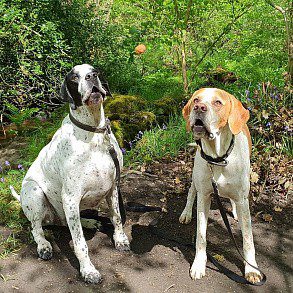

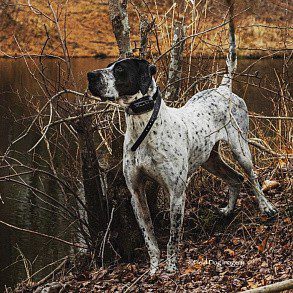

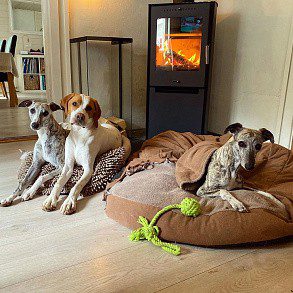

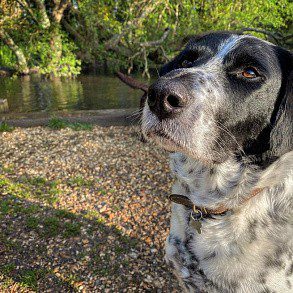

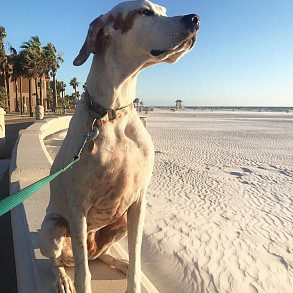

Character of the English Pointer
Developed hunting instincts did not crush the inner companion and friend of a person in the pointer, so it will not be difficult to get along with a four-legged athlete. Unlike most hunting breeds, these intelligent “English” willingly listen not only to the master’s opinion, so any member of the family who interacts with it from puppyhood is able to correct the dog’s behavior. The only caveat: in response to the willingness to cooperate, the cop requires timely human attention, expressed in communication, joint games and walks.
Territorial instincts are muted in English Pointers, so don’t try to force a watchdog job on the breed. Yes, a bored dog is able to phlegmatically bark at a stranger who opens the door, but this is where his mission, as a guard, ends. The pointer is not engaged in persecution of small pets, although occasionally it can break into a mouse that accidentally runs past. The only one the breed has yet to get along with is poultry, so when you take your dog on vacation to the countryside, you will have to constantly keep your finger on the pulse. Neighborhood chickens, ducks and geese lead the cops into an incredible temptation that they are unable to resist.
When describing the nature of the Pointer, breeders often joke that the breed has only two desires that are truly developed: to run and hunt. It makes sense to bring home a descendant of the Spanish Braccos only when you are ready to run through the fields and swamps with him. In other cases, it is better to prefer a less groovy pet to a restless pointer. In relations with children, the cops are moderately patient and indulgent. Of course, the dog will not transform into a vigilant nanny, but it will be happy to participate in outdoor games in which the youngest members of the family are involved.
Hunting with a pointer
Pointers are highly specialized cops, ideally working with upper distant flair. This means that the dog picks up and isolates the scent of potential prey as it travels through the air along with other field scents. Having found the object of persecution, the dog must signal this to the owner by making a stand. The next stage of the hunt is the eyeliner and raising the bird on the wing, that is, the animal must get close to the feathered game and frighten it away so that the person fires the most aimed shot.
An important nuance of hunting with an English pointer is the fidelity of instinct. It happens that the dog makes a mistake and makes a stand in the place where the bird sits (the location where the game hid earlier and from where it managed to fly away) or takes uncommercial birds for prey. In addition, the breed is characterized by a fast search, during which the dog explores the entire area of the field.
For full-fledged work with the pointer, it is necessary to work out the skill of the shuttle move – when the cop rushes ahead of the hunter, crossing his path in parallel lines. At the same time, the distance between each two such parallels should be at least 10 meters if the hunt is on a flat terrain.
Formally, pointers are not focused on feeding downed birds, but in practice, some individuals are able to do this. Of course, the dog will have to be taught to enter the water and swim for prey, but if you approach the process correctly, it will not take so much time to develop the skill. The only difficulty is the heat-loving nature of the breed, due to which swimming in the November ponds and swamps may not have the best effect on the health of the dog.
For your information: young pointers are best trained on a great snipe, which has a habit of moving short distances. Of upland game, the white partridge is suitable for the first experiments on training.
In pursuit of wild trophies, one should not forget about the elitism of the breed’s image, which developed back in the 19th century. Pointerists themselves call hunting with the descendants of the Spanish Braccos “ballet” and focus not so much on the result as on the aesthetics of the process. In this regard, attempts to retrain the pointer into a universal hunter with the makings of a hound cause a negative attitude of specialists. It is believed that this approach devalues the breed, since the working characteristics of the pointer have been formed over several centuries, not to be changed due to the momentary desires of the owner.
As for the duration of the hunt, it may be different at the beginning and end of the season. If the cop went out into the field or forest after a long break, it does not yet have sufficient endurance, which means that you can work with it no more than 3-4 hours a day. Moreover, if the Pointer is young enough, he needs to take 15-minute breaks during the entire period of work. By the end of the hunting season, the dog becomes stronger and able to work longer, so that the timing of hunting trips can be increased to 4 hours in the morning and 3 hours in the evening. It is also unacceptable to take your pet hunting for more than three days in a row – during the season, even the most tireless dogs need a timeout of a couple of days.
Education, training, coaching
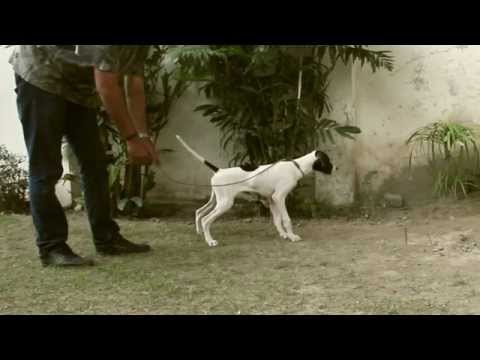

Watch this video on YouTube
Professional breeders assure that training a pointer is no more difficult than a drathaar. By the way, at first, cops-hunters are brought up and trained according to the same pattern as pets. Remember, if a dog is obedient and attentive at home, it will behave in a similar way in the working environment. And vice versa – an ill-mannered pointer will never become a patient hunter capable of getting at least some kind of trophy.
The first steps in training a puppy are socialization and the development of the habit of obeying a person. The kid must unconditionally accept the authority of the owner, but not see him as a tyrant who generously “writes out” punishments. In general, the style of communication with the Pointer should be restrained. It is equally impossible both to dissolve the cop and to push it into a rigid framework, since this is not a service breed. The first commands that the future hunter must learn are: “Lie down!” (can be replaced by the command “Down!”), “No!”, “Forward!”. Usually it takes a lot of time and effort to work them out, but since hunting without controls is nowhere, you will have to try.
Many owners train English Pointer puppies to fetch items. This is a valid and useful skill in the conditions of the upcoming hunt. However, it is important to understand that only puppies like to wear balls and tufts of feathers in their teeth. Over time, even among super-professional cops, interest in fetching and serving game decreases, and it is not always possible to return it back. If the pointer willingly jumps into the swamp for a shot duck, you can consider that you are very lucky with your pet.
Before proceeding to the nataska, they undergo preliminary training with the pointer. At this stage, the puppy must be taught to walk at the foot, to work out calliness (mandatory arrival at the owner’s call), the ability to lie down on orders at a distance and follow the direction indicated by the hunter. The habit of following at the feet of the owner is worked out with the help of a leash on daily walks. Bring to the dog’s mind the fact that you can not pull the strap and break ahead of the person. If the animal, though not perfect, but obediently keeps at its feet, use a treat to stimulate it. The cops love it when they encourage their success, and in the future they try to earn a delicacy in an honest way.
Execution of the command “Lie down!” at a distance – the most difficult exercise, because it is practiced on the street, where there are a lot of distractions. Along the way, you need to teach the dog to move in a given direction. It is better to do this by combining the commands “Right!”, “Left!” with pointing hand gestures – then with their help it will be easier to teach the pointer to shuttle search. After the preparatory stage has been completed, it is allowed to move on to the attack, which is formed from three main skills – pulls, racks and eyeliners.
The pointer’s pull is the ability to immediately isolate the smell of a bird. The faster the dog does this, the more valuable its work. A lot has been written about the showy stance of Pointers, so we can only add that, ideally, a short pull should turn into a sculpted stance, which the breed develops on an instinctive level. The culmination of hunting with a pointer is eyeliner. Having signaled the location of the game with the stand, the dog begins to approach it in order to frighten it away from the shot. However, in some cases it is recommended to skip this step. For example, when there is a hunt for swamp chickens and corncrakes. These birds do not always take to the wings and often prefer ground running to flight. As a result, instead of making an eyeliner, the pointer tries to follow the prey on the trail, which is contrary to the hunting characteristics of the breed.
An important moment in the training and training of English pointers is punishment. Experts recommend correcting misbehavior of puppies very gently until the age of three months. For example, if the animal is naughty and does not ask to go to the toilet, it can be threatened with a voice or a slight shake by the scruff of the neck. Presumptuous young individuals are offered by breeders to be lightly, but tangibly whipped with a rod. True, it is necessary to carry out “execution” only in exceptional cases. For example, when a dog knows and understands a command, but refuses to carry it out of spite and stubbornness.
English Pointer – Maintenance and care
Heat-loving and sociable pointers will be equally uncomfortable both in a street booth and in the cramped conditions of a city apartment. The best housing for a pointer is a house with a spacious yard, where the dog will not be restricted in movement and will be willing to both let it in and let it out. Some pointers prefer to keep their wards in aviaries. This is not ideal, but it is acceptable provided that the aviary and the booth located in it are as insulated as possible. Remember, the pet’s habitat should not be located in a damp and dark corner, but it should not be in direct sunlight either.
It is unacceptable to keep an English pointer on a leash – the dog must move freely around the territory of the fenced garden plot and at home. At the same time, bypassing the master’s property does not cancel daily walks. Twice a day, the Pointer must make an hour and a half promenade outside his own yard, regardless of the weather.
Hygiene
The working English Pointer is a problem-free dog in terms of hygiene needs. The hard, short hair of the cop does not get dirty and does not need frequent washing, trimming and combing, so you can brush over the pet’s body once or twice a week. True, if the animal lives in an apartment, it will be necessary to perceive as inevitable the hairs that have fallen out and “glued” to the soft upholstery, which do not want to be cleaned with a vacuum cleaner and a broom.
Increased attention is paid to the condition of the working pointer after the hunt. Upon returning from the field, you need to examine the paws and body of the dog, treating the scratches that were discovered with water, and then with an antiseptic. It is also mandatory to inspect the eyes and remove debris from them. Along the way, you need to feel the pet’s hair and remove ticks from it, if any, although it is more correct to treat the cops with ectoparasites in a timely manner.
Tip: it is better not to try to twist the tick, but to lubricate it with oil or gasoline. After a few minutes, the blood-sucking insect will fall off on its own, and you will have the opportunity to treat the bite site with iodine.
If the dog does not hunt for a long time, long claws grow in it, and the paw pads flatten. In this regard, before nataska and going out into the field, the claws must be shortened, and the overgrown hair between the fingers must be cut off, which will make the pet’s movements more free and eliminate the possibility of injury to the paws. Once a week, and also after hunting, the pointer’s ears are checked, removing dirt and sulfur from them with a clean rag soaked in a hygienic lotion from a veterinary pharmacy.
Feeding
As a true hunter, the English Pointer is supposed to be fed lean, sinewy meat, a variety of meat waste, as well as offal. Filleted sea fish, low-fat cottage cheese and a chicken egg are introduced into the diet several times a week to satisfy the body’s need for protein. The source of fat for pointers can be butter and vegetable oil, as well as beef tallow. True, the latter product is suitable only for healthy and active individuals.
The most popular dish among experienced pointers is meat porridge. It is boiled with rice and buckwheat, adding pieces of carrot or pumpkin. Growing pets benefit from calcium supplements selected by a veterinarian. The frequency of feeding pointers is the same as for other hunting breeds. Until the age of two months, puppies are fed up to 6 times a day, from two to four months – 5 times, from four to five months – 4 times, from five months to six months – 3 times, from six months – twice a day.
Some breeders do not feed the cops before the hunt, sincerely believing that on an empty stomach the pointer’s flair sharpens and he concentrates better on the process of tracking prey. In fact, the dog’s nutrition at the height of the hunting season should be enhanced, otherwise the animal will have nowhere to draw energy from. True, in order to avoid intestinal volvulus, you need to treat the hunting pointer no later than 2 hours before leaving for the field, and it is better if it is not a hearty meal, but a small snack. The pointer is fed more thoroughly after the hunt – this is an old tradition that educates the dog in understanding the importance of the work process.
Health and disease of English Pointers
English Pointers are described by veterinarians as a strong, healthy breed, but with a predisposition to arthritis and hip dysplasia. With age, animals can overtake eye diseases – retinal atrophy, corneal dysplasia, cataracts. Sometimes pointers are diagnosed with pannus, a chronic inflammation of the cornea and limbus, which manifests itself mainly in individuals older than 4 years.
How to choose a puppy of English Pointer
- The best way to test the working genes of a breed is to take stud dogs and studs out in the field to see for yourself the quality and length of their pull. Accordingly, if there is a professional hunter in your environment who sells offspring from his wards, try to get out with him and his pets for game.
- The presence of a field diploma in a female and male English Pointer does not guarantee hunting feats in offspring. If the achievements of the puppies’ parents are extremely important, give preference to cops that have passed not lockal, but international field tests. According to breeders, domestic pointer competitions do not reveal the hunting skills of dogs, but only confirm that they have an instinct for getting food and a willingness to work.
- You can check the puppies for courage and poise of the psyche simply by lifting them by the withers above the floor. If the baby squeals, breaks out, and after being put on his feet, goes to the side or stands in indecision, this indicates a weakness of nature, as well as excessive timidity.
- English Pointers, like all cops, are quite affectionate, but for hunting you should not choose a toady puppy that endlessly rubs against the breeder’s legs, looking into the eyes. It is much easier to train such individuals, but the effectiveness of their field work is low.
- Consider the type of temperament of puppies. Phlegmatic pointers have a sluggish move and sin with a short search. Individuals of the choleric warehouse are more energetic and quicker, but sometimes they practice an unsystematic search and mating of birds, and besides, they are not always obedient.
English pointer price
The average price of an English Pointer puppy from local breeders is 400-600$. Babies from working parents, but with not the purest pedigrees or without them at all, as well as offspring from unscheduled matings, go for 200 – 300$. If you don’t want to bother with nataska and you need a trained pet, you can purchase an adult trained pointer, for which you will have to pay about 500$. A separate caste is made up of adult cops with pedigrees of the RKF, who have hunting diplomas and participated in exhibitions. The cost of such pointers can reach 1000$ or more.





